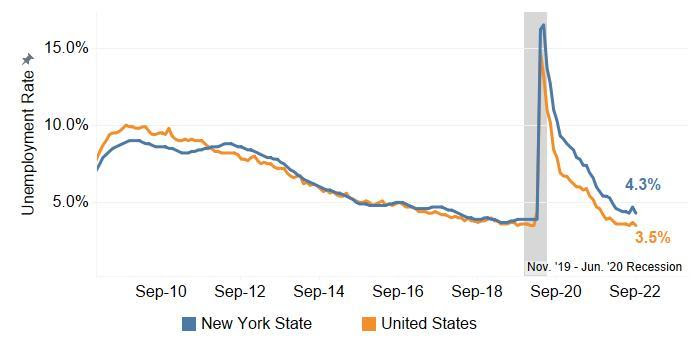
According to preliminary seasonally adjusted figures released today by the New York State Department of Labor, the number of private sector jobs in New York State increased over the month by 17,400, or 0.2%, to 8,061,500 in September 2022. The number of private sector jobs in the U.S. also increased by 0.2% in September 2022.
New York State's private sector jobs (not seasonally adjusted) increased by 361,400, or 4.7%, over the year in September 2022, which exceeded the 4.2% increase in the number of private sector jobs in the U.S.
New York State's seasonally adjusted unemployment rate decreased from 4.7% in August to 4.3% in September 2022. From September 2021 to September 2022, the unemployment rate (not seasonally adjusted) fell from 5.7% to 3.9%.
From August to September 2022, New York State's labor force (seasonally adjusted) decreased by 36,600. At the same time, the labor force participation rate went down from 60.5% in August 2022 to 60.3% in September 2022.
The number of private sector jobs in New York State is based on a payroll survey of New York businesses conducted by the U.S. Department of Labor’s Bureau of Labor Statistics (BLS). Monthly payroll employment estimates are preliminary and subject to revision as more complete data become available the following month. The BLS calculates New York State’s unemployment rate based partly upon the results of the monthly Current Population Survey (CPS) of approximately 3,100 households in the State.
Note: Seasonally adjusted data are used to provide the most valid month-to-month comparison. Non-seasonally adjusted data are valuable in year-to-year comparisons of the same month – for example, September 2021 versus September 2022.
Statewide Industry Employment
September 2022 – Seasonally Adjusted
- On a net basis, the total number of nonfarm jobs in the state increased by 15,600 over the month, while private sector jobs rose by 17,400, in September 2022.
At the same time, the total number of nonfarm jobs in the nation increased by 263,000, while private sector jobs increased by 288,000.
NYS Job Growth Equals Nation’s
Over-the-Month % Change in Total Nonfarm & Private Sector Jobs, August – September 2022
 Total Nonfarm and Private Sector Jobs Increased in September 2022Total Nonfarm and Private Sector Jobs (in 1000s), September 1990 – September 2022
|





No comments:
Post a Comment